Homemade soda is a naturally fermented drink made with a ginger bug. Fermented soda is a fun project that ends in a delightfully fizzy drink that has wonderful probiotic and herbal healing powers. In this recipe, yarrow is paired with fresh strawberries, wild rose petals, and lemons for a refreshing summer drink!
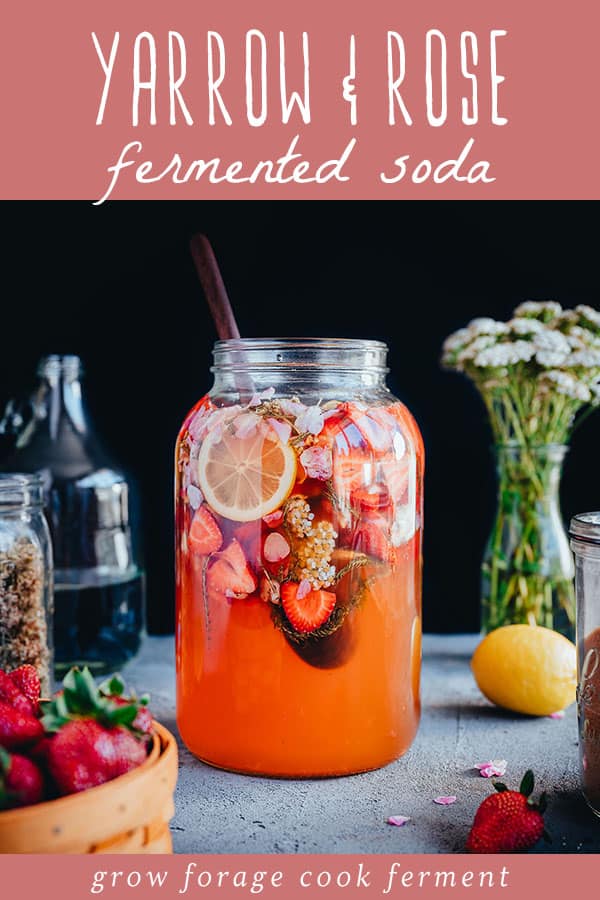
Want to save this post for later?
What is Fermented Soda?
Fermented soda is an easy-to-make, probiotic-rich, homemade brew that can be flavored in a variety of ways. Using a wild fermented ginger bug is a great way to begin this process.
Fermented homemade sodas turn out fizzy and refreshing, and with added herbal goodness depending on how you choose to flavor it, they have a wide array of health-supporting possibilities!
Here are 12 Fermented Soda Recipes to try!
Get recipes using wild violet, lilac, forsythia, chive, calendula, lavender, white clover, nasturtium, elderflower, yarrow, rose, and Queen Anne’s lace flowers in my ebook Edible Flower Recipes: Infusions, Syrups, Jellies, Beverages, & Snacks!
Are Fermented Drinks Good for You?
Yes! Fermented drinks have a host of beneficial bacteria that are immune-boosting and good for healthy gut flora. With seasonal added ingredients, you can increase the “good for you” quality of your homemade sodas depending on what is needed.
Fermented elderberry soda is a good example of an extra antioxidant and immunity boost during autumn when elderberries are ripe – right when you need it!
Does This Homemade Soda Have Alcohol?
The soda will contain a small amount of alcohol due to the fermentation, although it’s a very low amount.
If you want a more-alcoholic soda, that can be achieved with a second ferment which basically gives the soda extra fermenting time which will lead to a more vinegary taste and higher alcohol content.
Ginger Bug for Fermented Drinks
The main goal of making a ginger bug in the first place is to make fermented sodas or ginger beer.
A ginger bug is a traditional wild fermented ginger starter, so no commercial yeast is added. Instead, it uses the natural yeast from the ginger.
One of my favorite things about ginger bugs is that using this process to ferment and start natural homemade sodas stems from the practice of natural fermenting which is one of the oldest methods of preservation.
This fizzy and bubbling gingery beauty is a staple that can be used for many recipes!
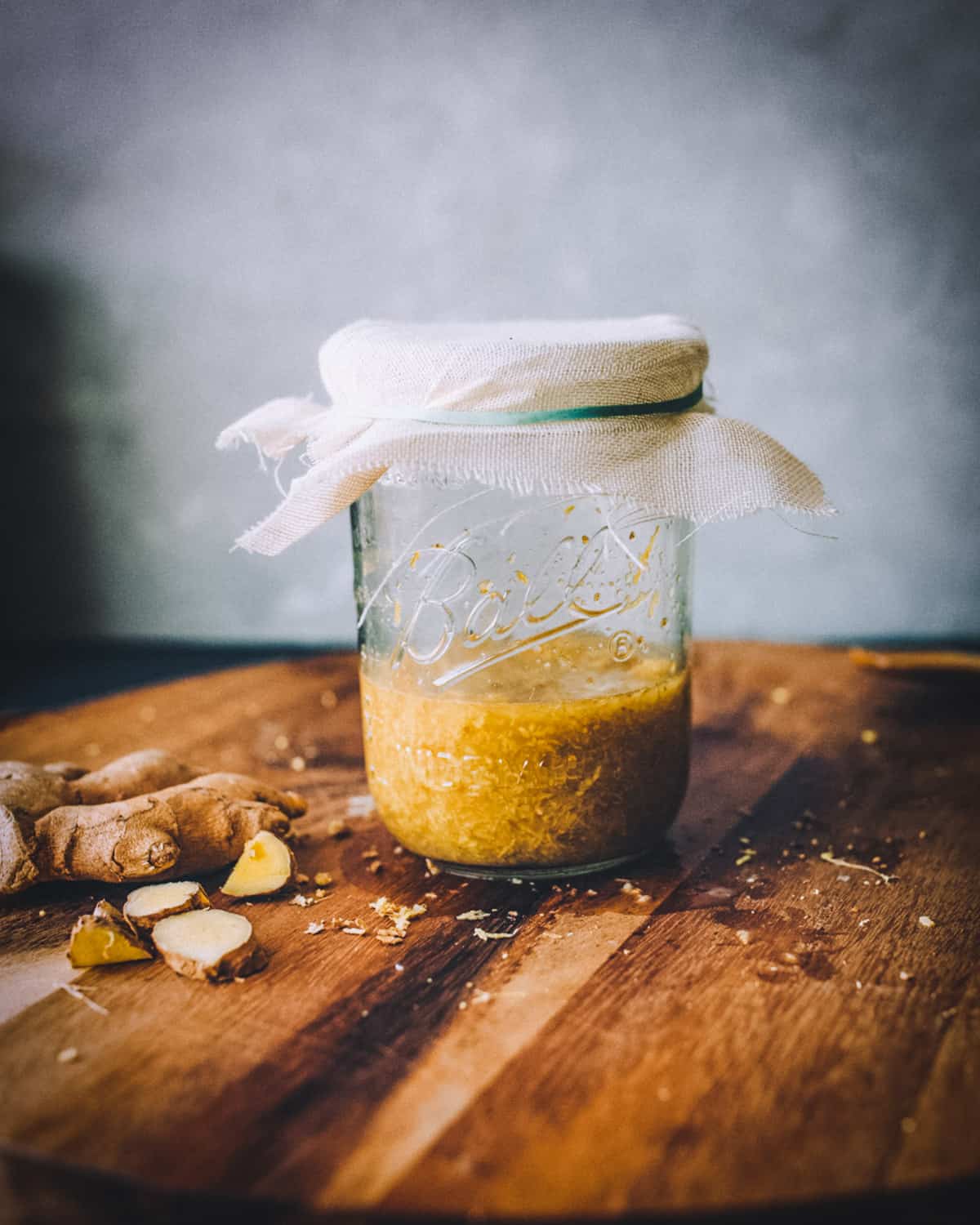
Ingredients
Non-chlorinated water, if you aren’t sure about your tap water I recommend using filtered water. Chlorine can inhibit the fermentation process.
Fresh strawberries, garden-grown or found at a farmer’s market are perfect!
Brown sugar gives the ginger bug fuel to create the delicious fizzy quality of this homemade soda.
Fresh rose petals are soothing, healing, and help clear toxins from your body. Forage for wild rose or use non-sprayed cultivated rose petals. They’re also great in homemade kombucha!
Lemons add a lovely tart and refreshing summery taste to this fermented drink.
With dried yarrow leaves and flowers, you can forage yarrow yourself or in a pinch, you can purchase dried yarrow if needed.
Ginger bug yeast starter is the base of this homemade soda, and gives it all of the fermented bubbly goodness you want! It takes just a few days to get one going and is an easy and mostly hands-off process.
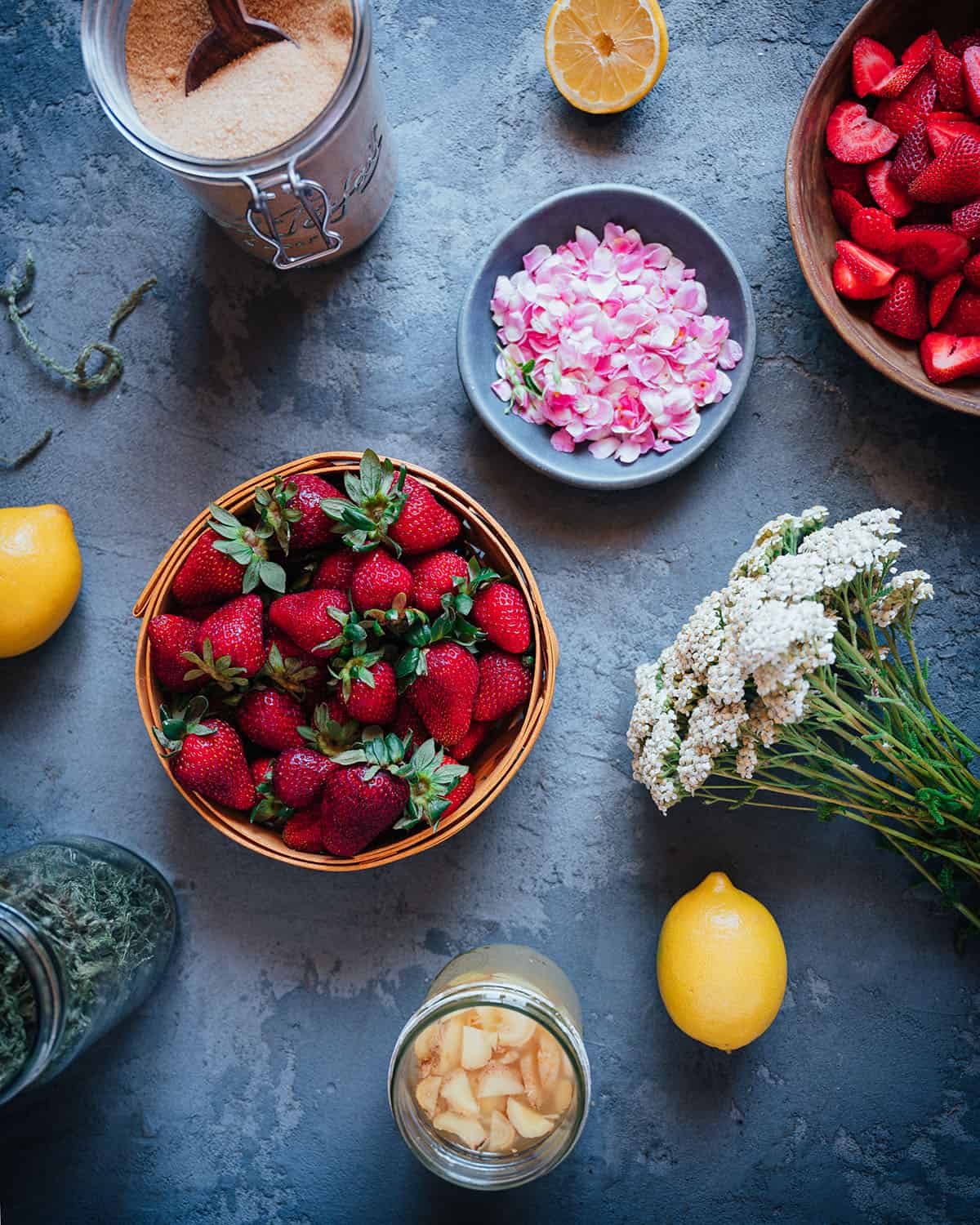
Using Yarrow for Brewing
Yarrow (Achillea millefolium) is an aromatic and bitter medicinal herb native to North America, Europe, and Asia. With bittering, antibacterial, antiseptic, and antimicrobial properties yarrow was an important medicinal plant.
Those same properties could balance and protect an ale from spoiling. Yarrow also adds an inebriating quality, making any ale brewed with yarrow more potent.
Today, these properties are thought to stem from thujone. Thujone can be found in several common plants, including sage, coriander, and tarragon; but its notoriety comes from its connection to wormwood, which is used to make absinthe.
Yarrow leaves are used for bittering and the flower is used for both bittering and its aromatic qualities. Harvest yarrow leaves anytime during their growing season from spring to early fall.
Harvest the flowers as they first open and become fully vibrant, but before they start to turn brown and dry out.
Only harvest fresh, healthy-looking leaves and flowers free of mildew or grey fungus.
The bitterness varies depending on location and soil conditions. Some yarrow is mildly bitter and very aromatic to overwhelmingly bitter.
Start small when adding yarrow to a brew, with up to ½ ounce of fresh leaves and blossoms early in the boil to add a mild, sage-like bitterness to beers and sodas.
Yarrow can be paired with other ingredients to balance the flavors and add a mild bitterness for a more complex beverage.
Here, yarrow is paired with fresh strawberries, wild rose petals, and lemons for a refreshing summer drink. The yarrow adds just enough bitterness to add interest and balance the sweet and tart flavor.
Yarrow is also wonderful in body care products like this yarrow and rose soap or arnica and yarrow skin cream.
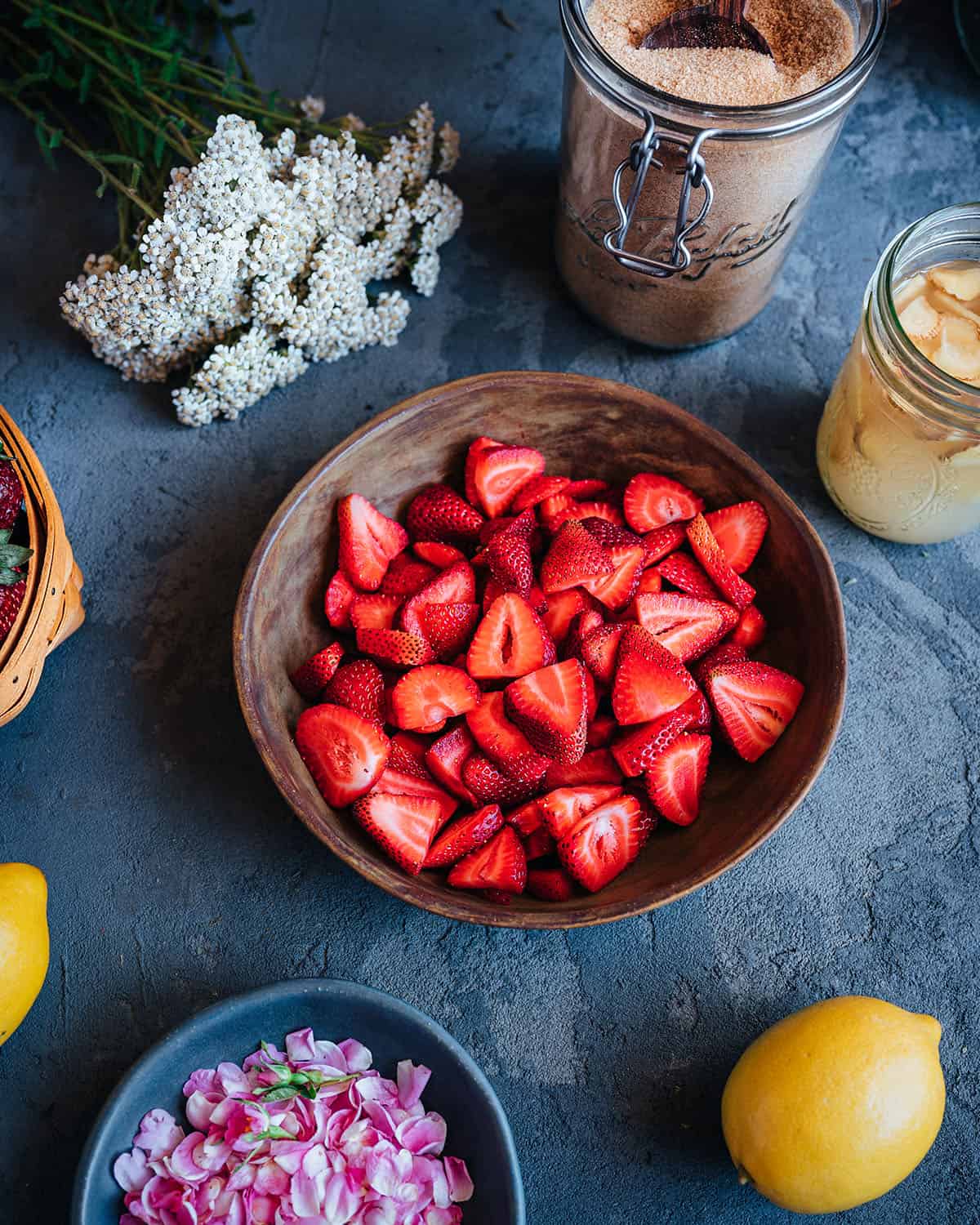
Homemade Soda with Yarrow, Rose, and Strawberry Recipe
Don’t Forget About the Ginger Bug!
The very first thing you need to start this soda recipe is an active ginger bug to kickstart the fermentation.
If you don’t have a ginger bug on hand, it’s a simple process that takes only about 3-5 days to make a new one.
Make the Yarrow Soda Base
For the homemade soda, mix the water, yarrow leaves, and brown sugar in a large pot. Bring the solution to a boil and let it boil for 30 minutes.
I like to add the yarrow flowers during the last 5 minutes of boiling for an extra kick of flavor and aroma. Then remove the pot from the heat and add the lemons.
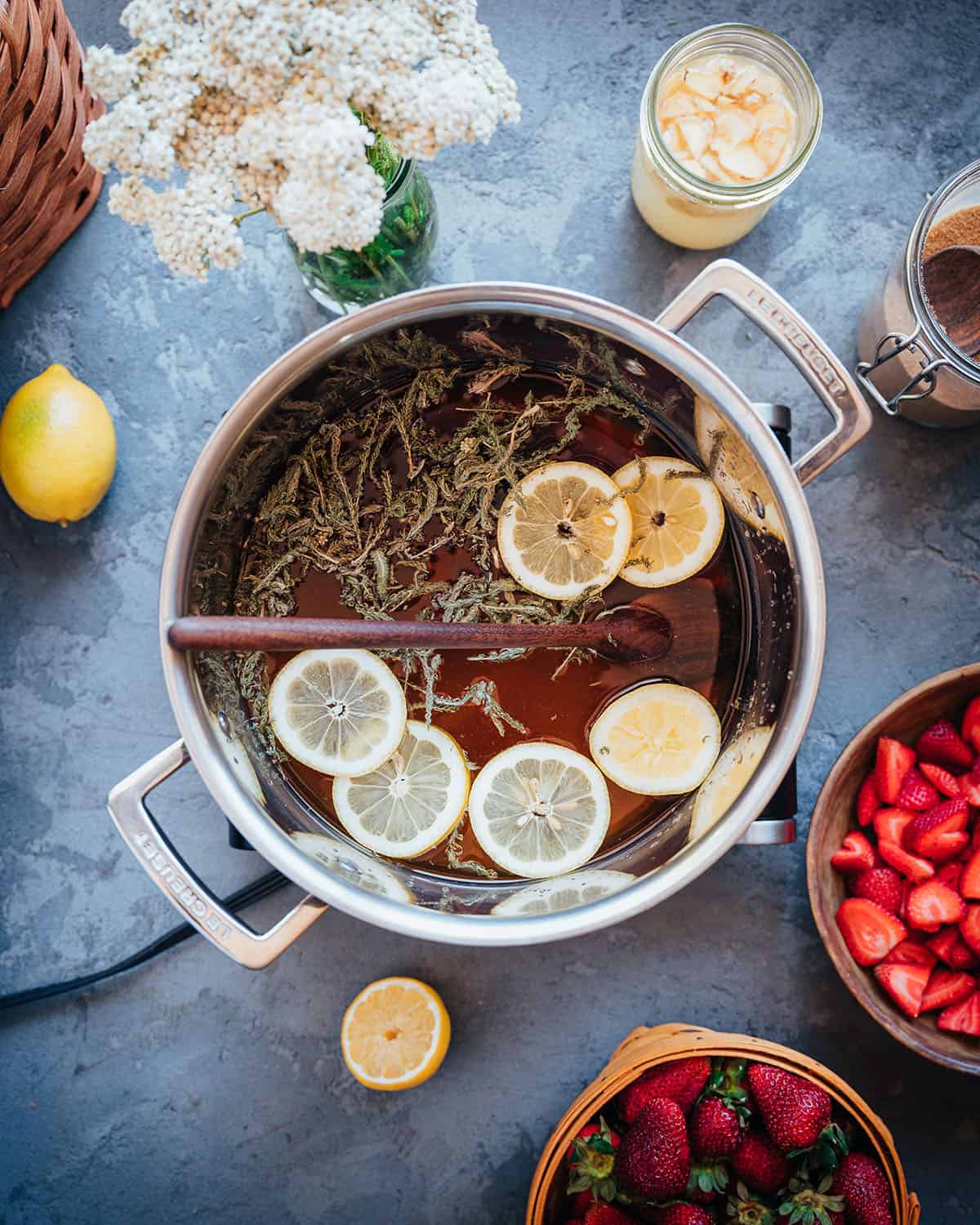
Allow the solution to cool to room temperature – about 70 degrees F – then strain into a gallon jar.
If you want to speed up the cooling process, you can place the pot in a large bowl filled with ice water. Make sure you keep the pot covered to prevent contamination while the solution is cooling.
Ferment the Soda
Add in the fresh strawberries, rose petals, and ginger bug. Then add more water as needed to fill the gallon jar to the top, leaving a couple of inches of headspace.
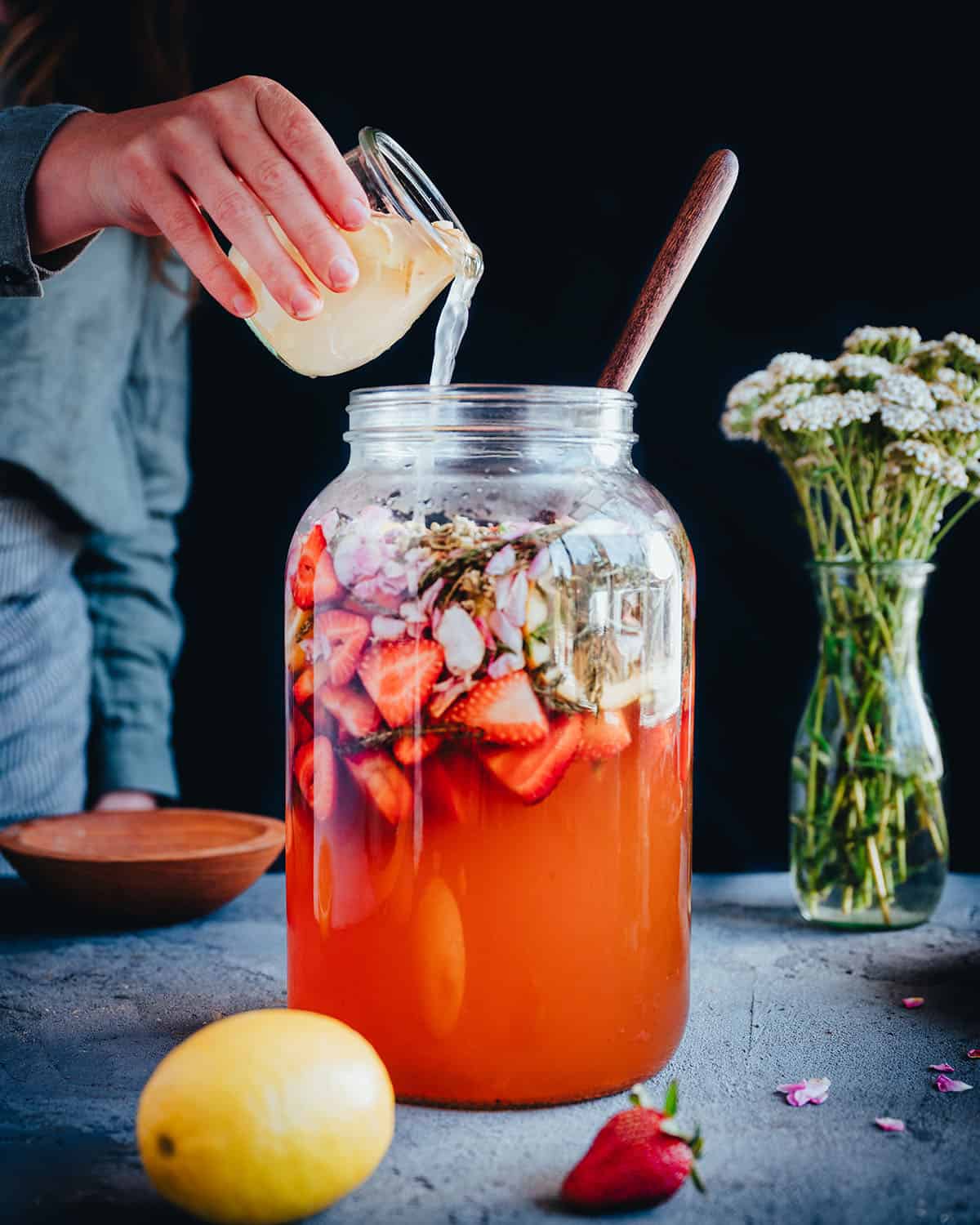
Mix it all up with a clean long-handled spoon and cover the jar with an airlock or tightly woven cloth to keep small bugs out (or toy dinosaurs, cat hair, what have you).
Leave it to ferment at room temperature for 2 to 3 days, then you can use a clean spoon to stir the brew several times a day and watch for bubbles to appear when you mix.
Feel free to taste the brew with a straw and add more sugar as needed to maintain the sweetness level you prefer. Add up to 1/2 cup more sugar if desired.
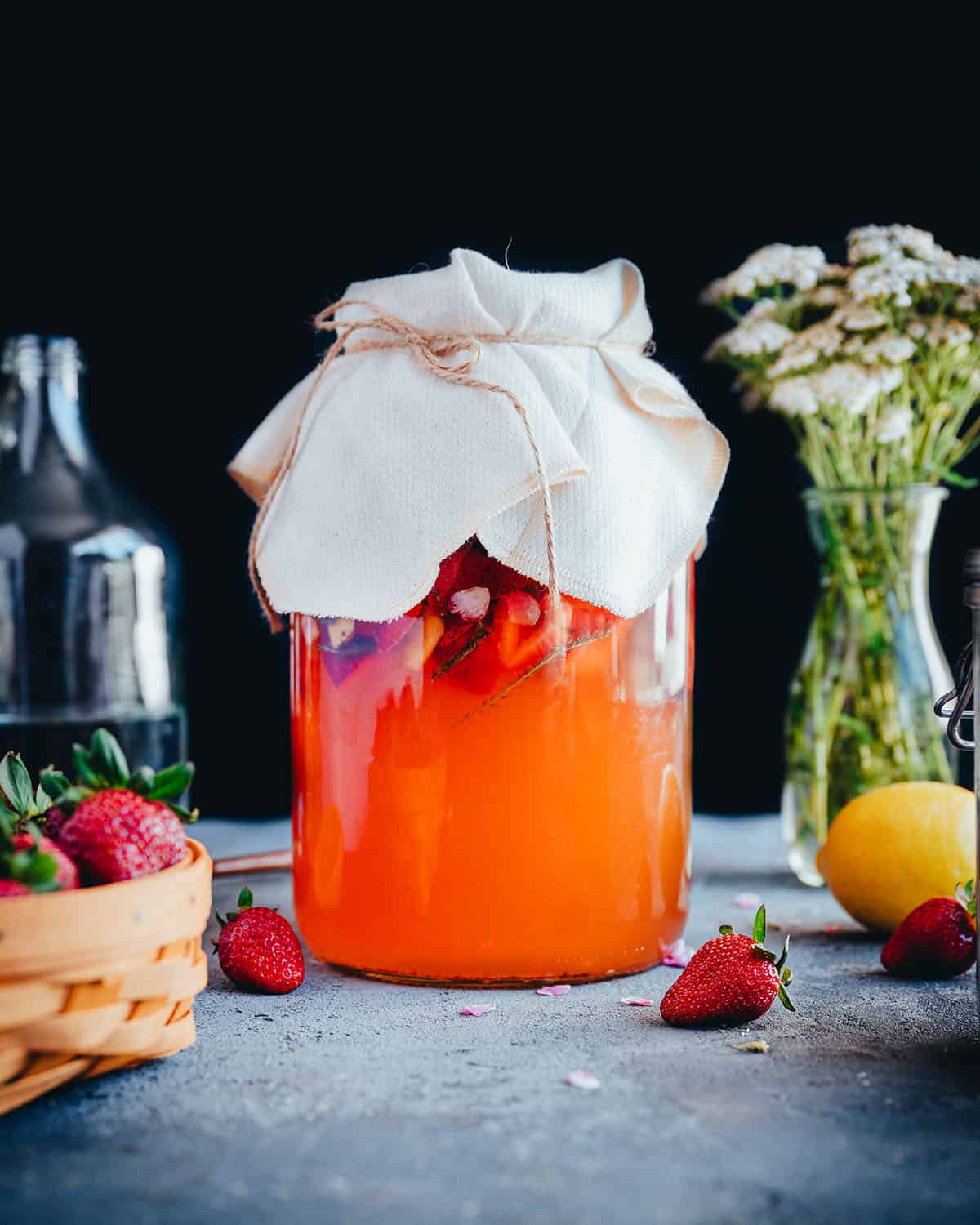
In making homemade soda with a ginger bug, the fermentation is typically very active by day 2. It’s good to keep a close eye on the strawberries and strain them out before they become mushy and start to smell spoiled.
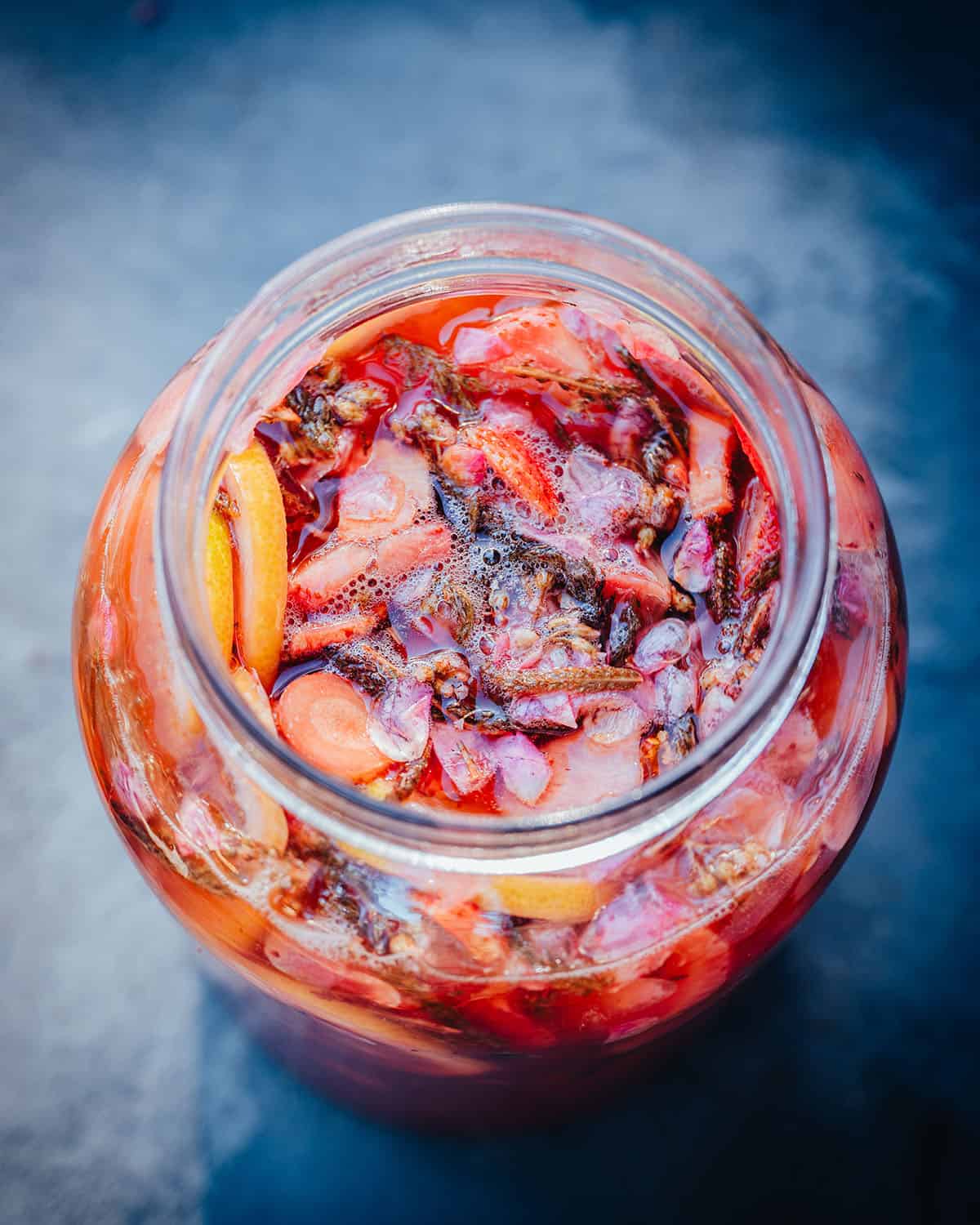
Bottle the Soda: 2 Ways
Strain the soda into a clean container and bottle or place it in a clean fermentation vessel with an airlock for a higher alcohol level.
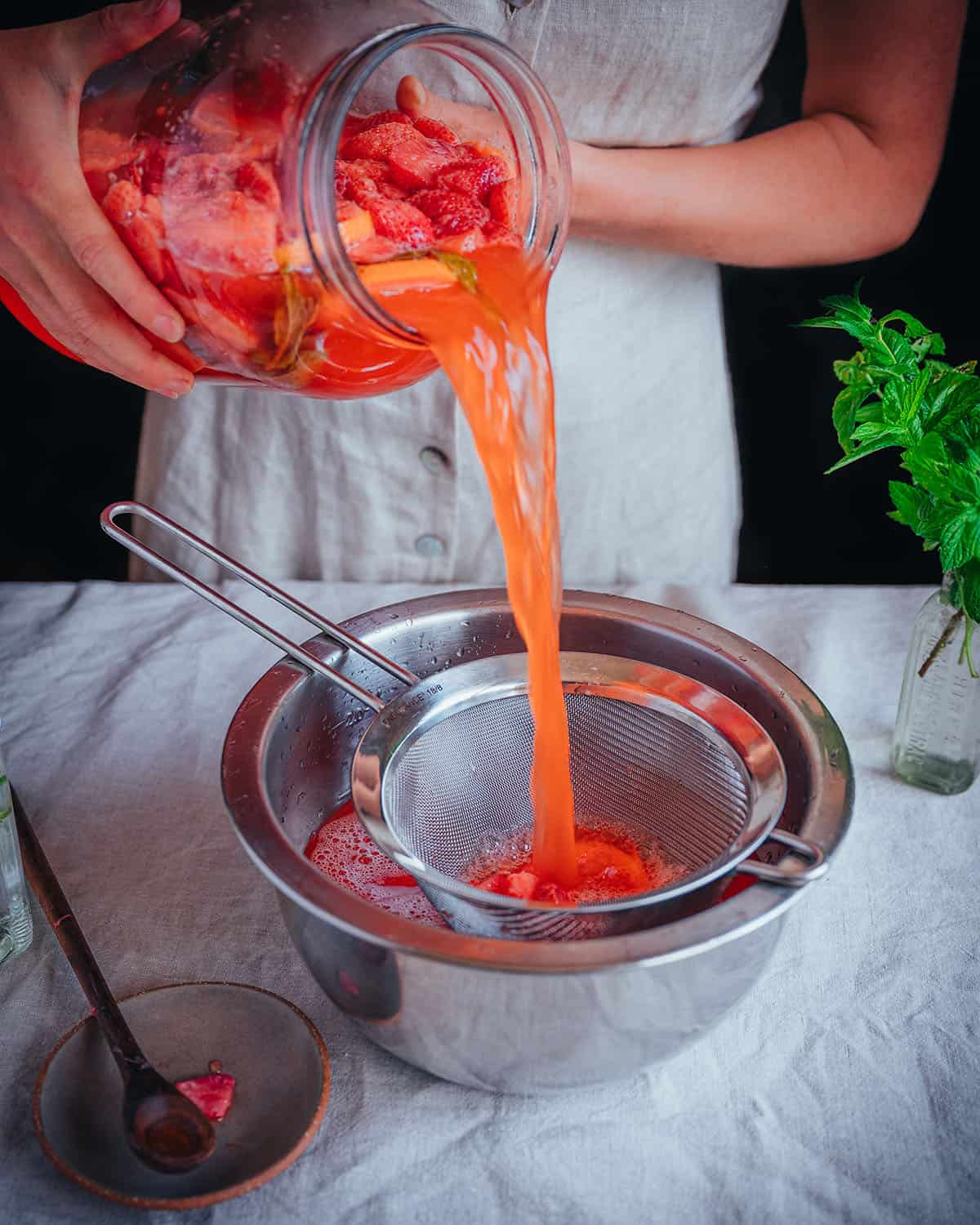
Option 1: For a low-alcohol fizzy soda, bottle the brew immediately into flip-top bottles.
Let them sit at room temperature for an additional 8 hours to build pressure. Just remember to burp the bottles to release the pressure every 8 hours or so.
Refrigerate the soda once you are happy with the fizziness to slow down the fermentation. Enjoy within a week or so!
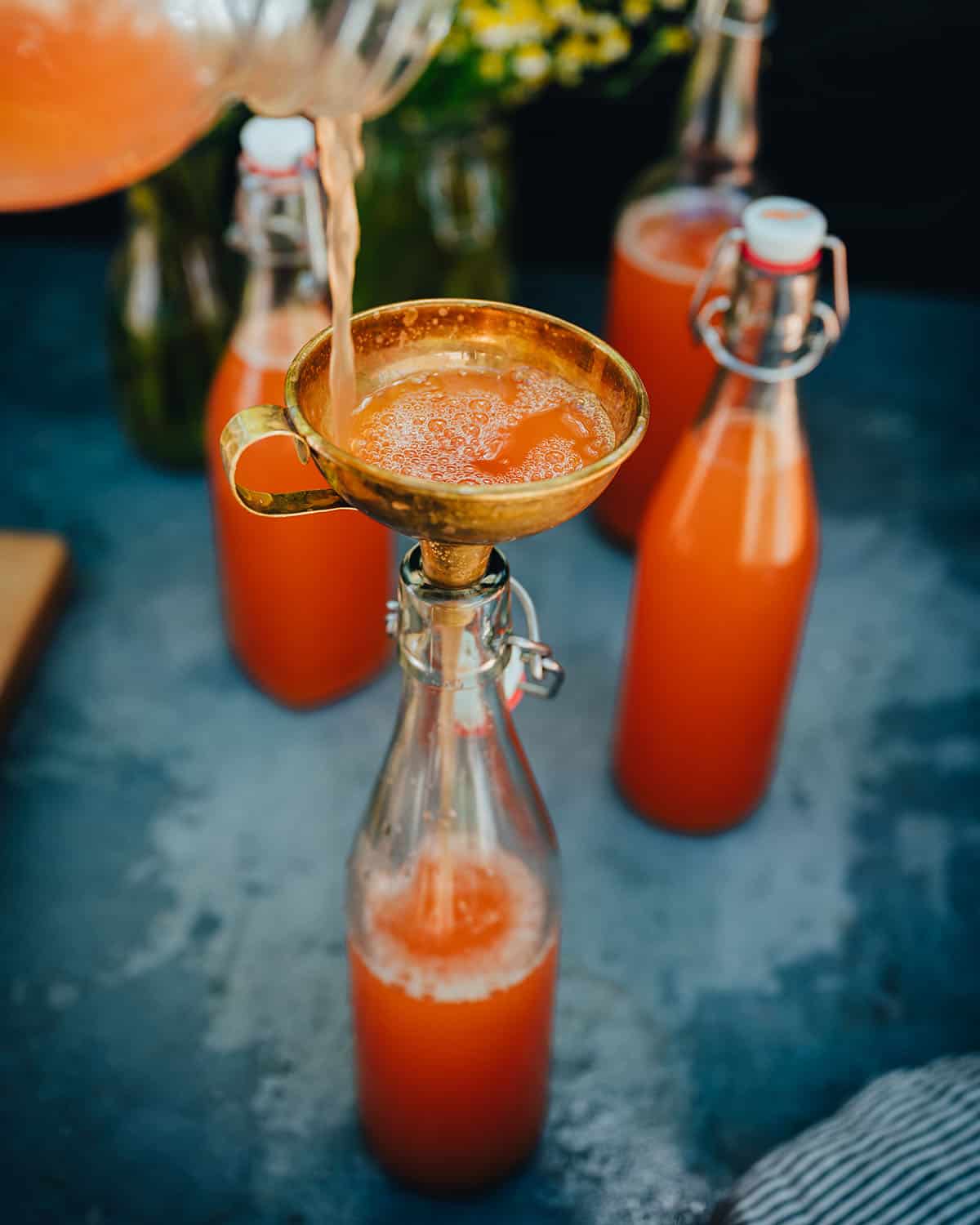
Option 2: For a boozier soda, strain the soda into a glass carboy and top with an airlock. Ferment for an additional 2 or 3 days before bottling. Add ¼ tsp sugar to each bottle for carbonation.
Follow the same steps as above for building carbonation, then refrigerate.
Note: The soda will contain a small amount of alcohol due to the fermentation.
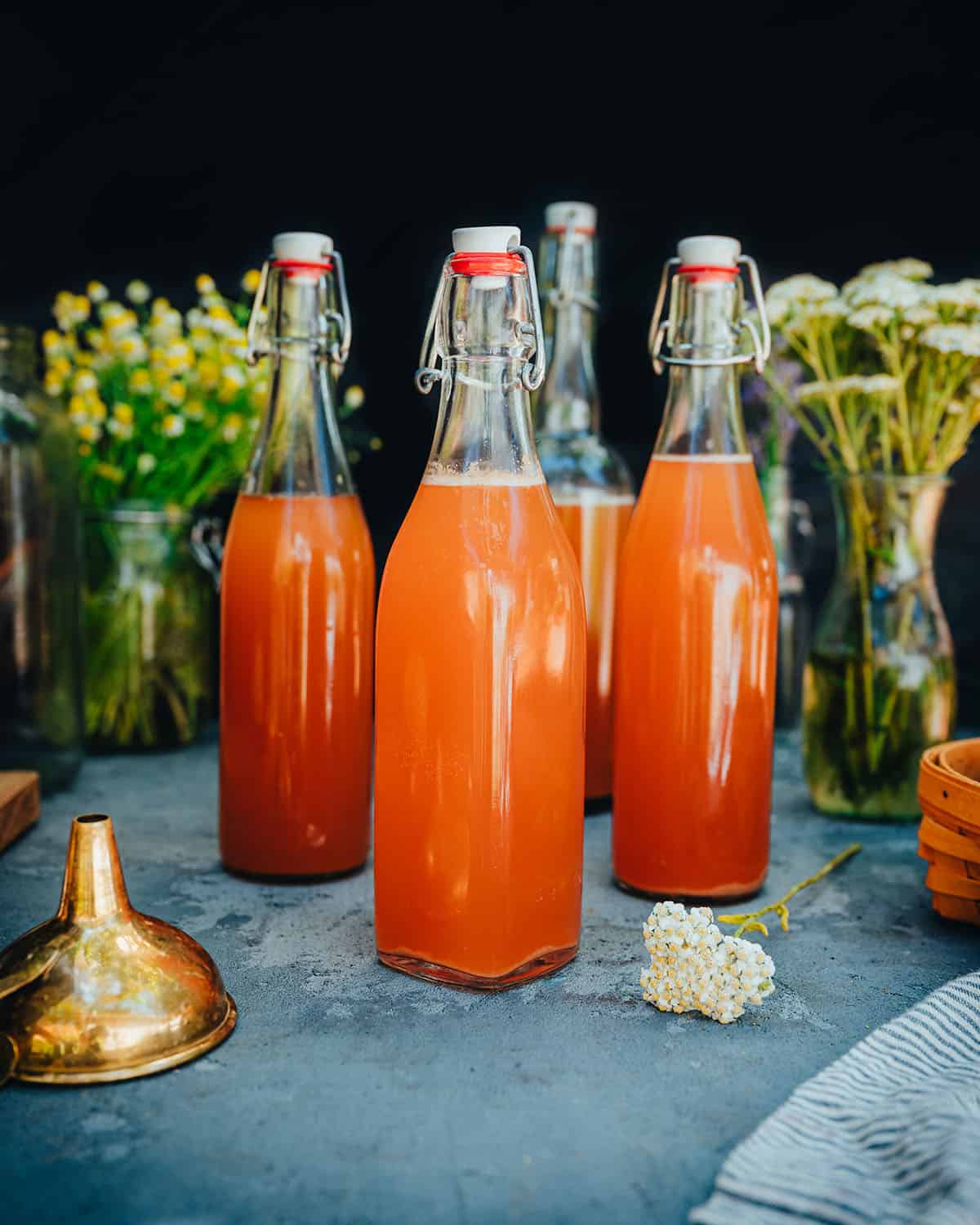
How to Serve Fermented Homemade Soda
Once finished, this soda is light and bubbly with an amazing summery herbal taste. Serve it over ice with strawberry and lemon slices. Perfect for a warm afternoon!
Homemade soda is the best way to keep some bubbles in your afternoon without all of the toxic ingredients in grocery-store brands.
The probiotics and herbal health benefits of this fermented soda make for a refreshing drink when you need one. Cheers!
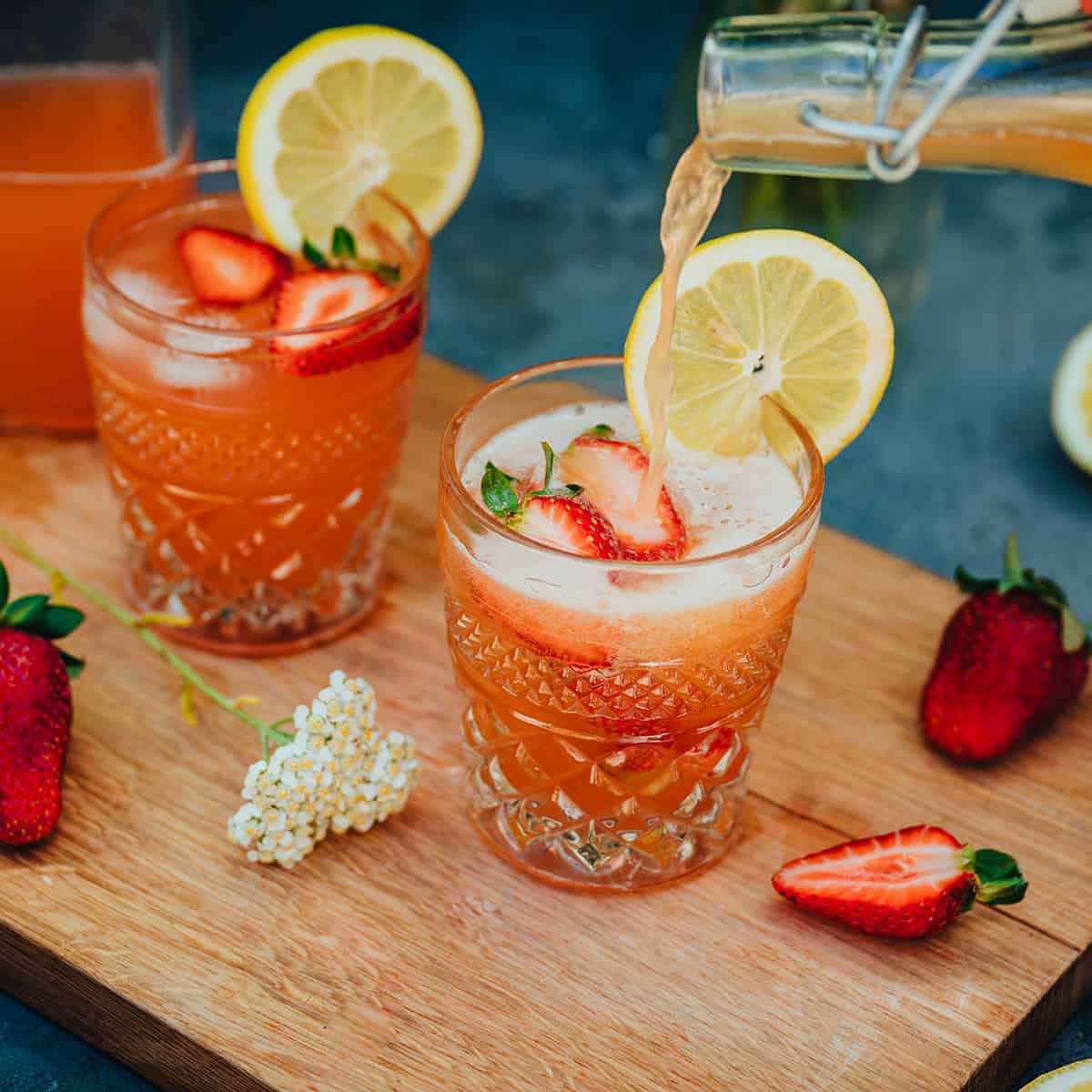
More naturally fermented soda recipes:
- Homemade Strawberry Rhubarb Soda
- Fermented Elderberry Soda
- Naturally Fermented Turmeric Soda
- Fermented Root Beer
- Herbal Water Kefir Soda
- Apple Ginger Beer
- Pine Needle Soda
- Strawberry Water Kefir Soda
Homemade Soda with Yarrow, Rose and Strawberries
Equipment
- One Gallon Glass Jug with Airlock (includes lid) (for a boozier soda)
Ingredients
- 3 quarts water non-chlorinated
- 1 lb. strawberries sliced
- 1 pound brown sugar packed, plus an additional ¼ lb. for later
- 1-2 cups fresh rose petals adjust the amount based on how potent they are
- 2 lemons
- 4 grams dried yarrow leaves
- 4 grams dried yarrow flowers
- ½ to ¾ cup ginger bug
Instructions
- Before starting, you will need an active ginger bug to kickstart the fermentation. If you don’t have a ginger bug on hand, it takes about 3-5 days to make a new one. (Ginger bug recipe)
- Mix the water, yarrow leaves, and brown sugar in a large pot. Bring the solution to a boil and let it boil for 30 minutes. For more flavor and aromatic qualities, add the yarrow flowers during the last 5 minutes of boiling.
- Remove the pot from the heat and add the lemons. Allow the solution to cool to room temperature or 70° F (21° C) then strain into a gallon jar.
- To speed up the cooling process, you can place the pot in a large bowl filled with ice water. Keep the pot covered to prevent contamination while the solution is cooling.
- Add the fresh strawberries, rose petals, and ginger bug. Add more water as needed to fill the gallon jar to the top, leaving about 2 inches of headspace. Mix well to incorporate with a clean spoon and cover the jar with an airlock or tightly woven cloth to keep small bugs out.
- Ferment at room temperature for 2 to 3 days. Use a clean spoon to stir the brew several times a day and watch for bubbles to appear when you mix. Taste the brew with a straw and add more sugar as needed to maintain the sweetness level you prefer. Add up to ¼ lb. more sugar.
- With a ginger bug, the fermentation is typically very active by day 2. Keep an eye on the strawberries and strain them out before they become mushy and start to smell spoiled.
- Strain the soda into a clean container and bottle it, or place it in a clean fermentation vessel with an airlock for a higher alcohol level. See options 1 and 2 for bottling in the notes below.
Notes
- Bottling Option 1: For a low-alcohol fizzy soda, bottle the brew immediately into flip-top bottles. Let them sit at room temperature for an additional 8 hours to build pressure. Just remember to burp the bottles to release the pressure every 8 hours or so. Refrigerate the soda once you are happy with the fizziness to slow down the fermentation. Enjoy within a week or so!
- Bottling Option 2: For a boozier soda, strain the soda into a glass carboy and top with an airlock. Ferment for an additional 2 or 3 days before bottling. Add a ¼ tsp sugar to each bottle for carbonation. Follow the same steps as above for building carbonation, then refrigerate.
- Note: The soda will contain a small amount of alcohol due to the fermentation.
- If it’s really warm out, you may want to “burp” your bottles once or twice by opening and then resealing them to release the pressure. This wild fermented soda can really produce a lot of bubbles, so you want to make sure that your bottles don’t explode!

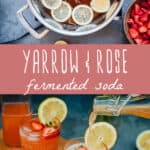
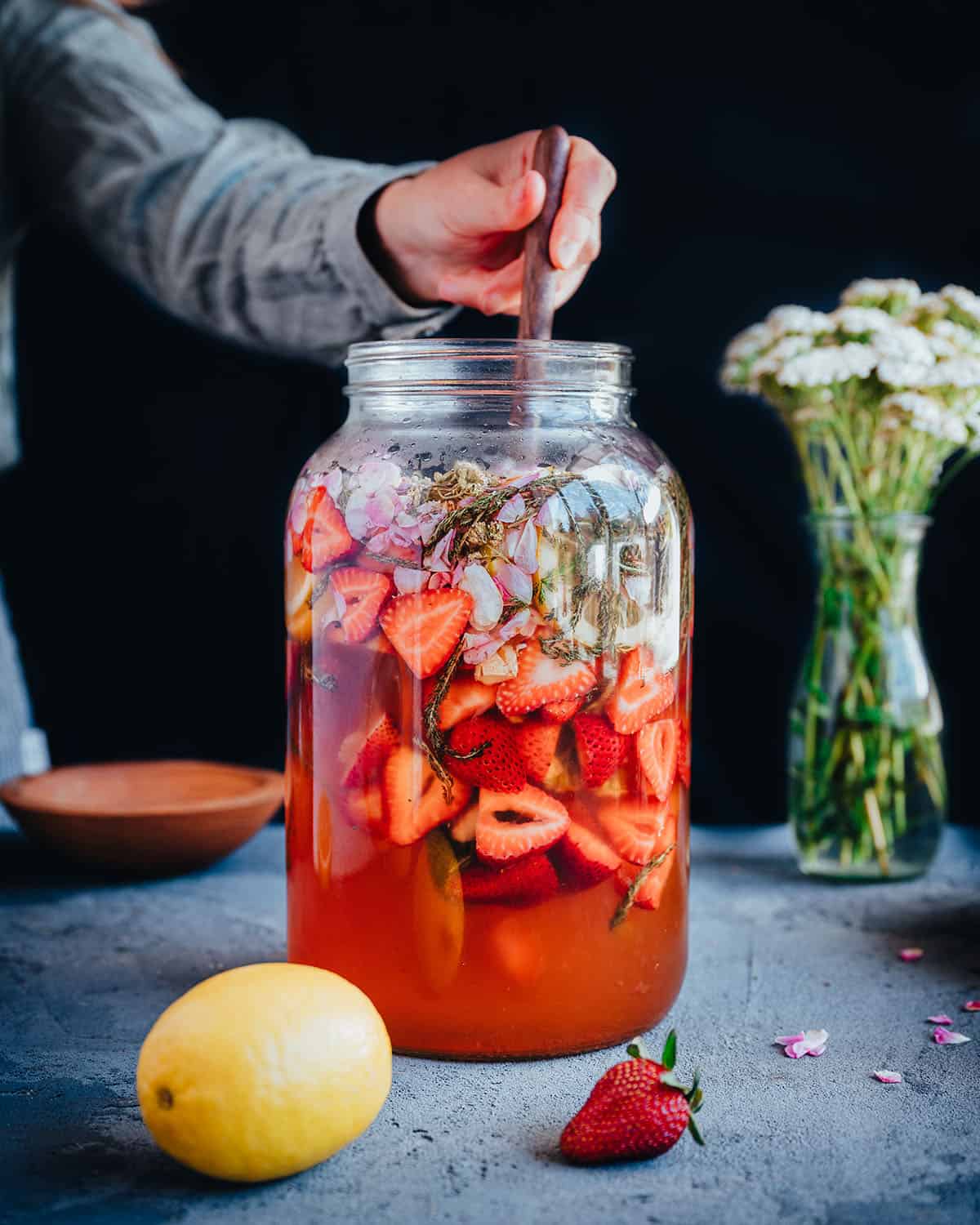
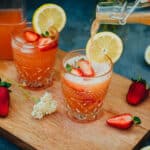

It’s so funny that you mentioned keeping you dinosaurs out. I was making Kombucha one day and found a toy dinosaur! The scoby had grown right around it lol
Hey there, so i am wondering why does the it become nore boozie if you put it into a flip top bottle. Is it because of a longer fermentation time? Thanks
Hi Jasmine. I’ve never heard that before. Do you mean, why does it become more bubbly?
Whe i read this section below i thought you were saying if you wanted a boozier version to do this…
Bottling Option 2: For a boozier soda, strain the soda into a glass carboy and top with an airlock. Ferment for an additional 2 or 3 days before bottling. Add a ¼ tsp sugar to each bottle for carbonation.
I am trying to make a boozier version. I even thought about adding champagne yeast. What do u think about that or have u done anything like that before?
Thanks Jasmine
Hi Jasmine. Thanks for the clarification. Yes, with additional fermentation with an airlock, your fermented soda will become alcoholic, aka, boozier. The ginger bug should ferment your soda well enough that champagne yeast would be unnecessary.
If I left it for longer what would the alcohol level be? Like 5%?
I’m not sure. You would have to measure with a hydrometer.